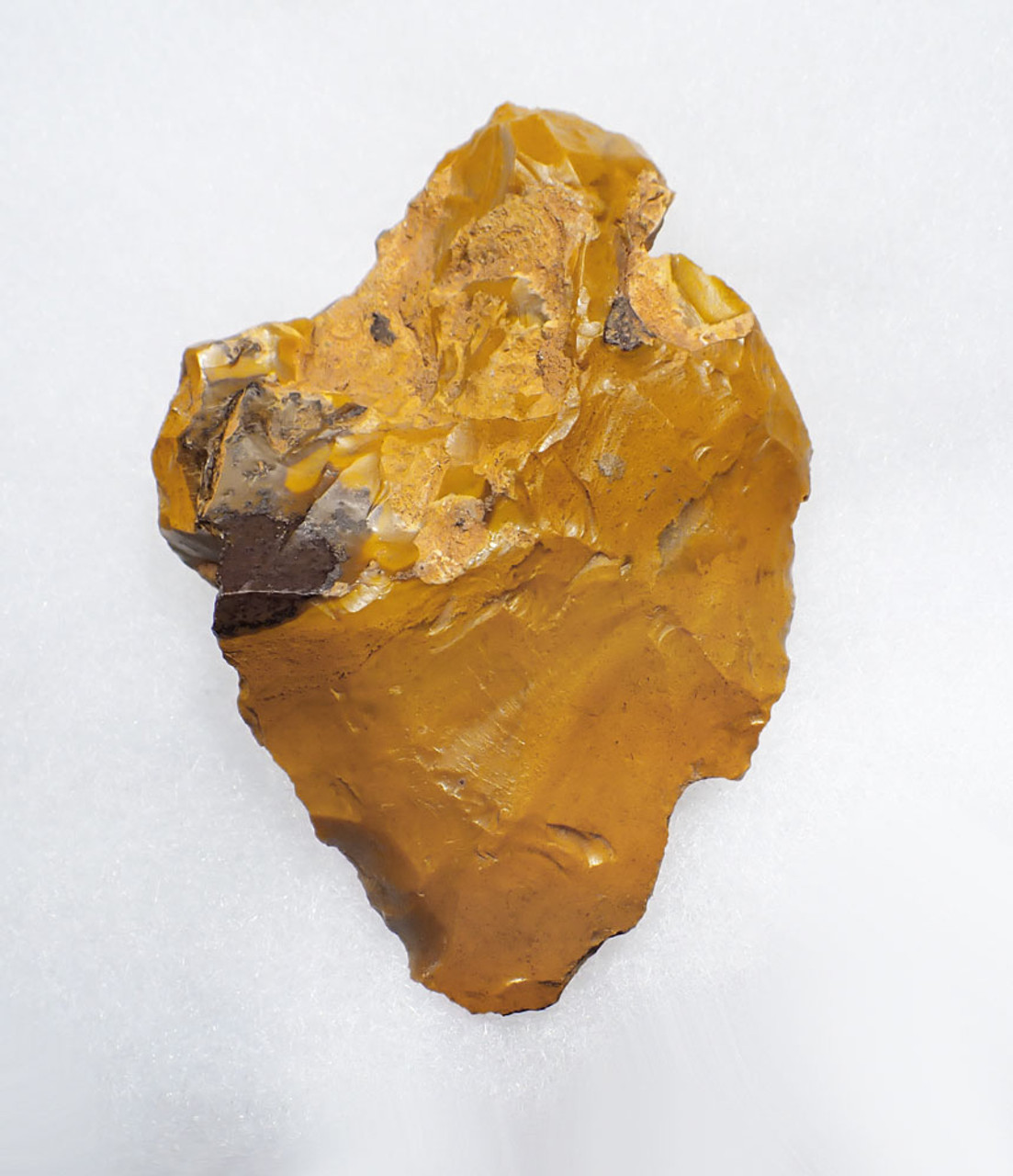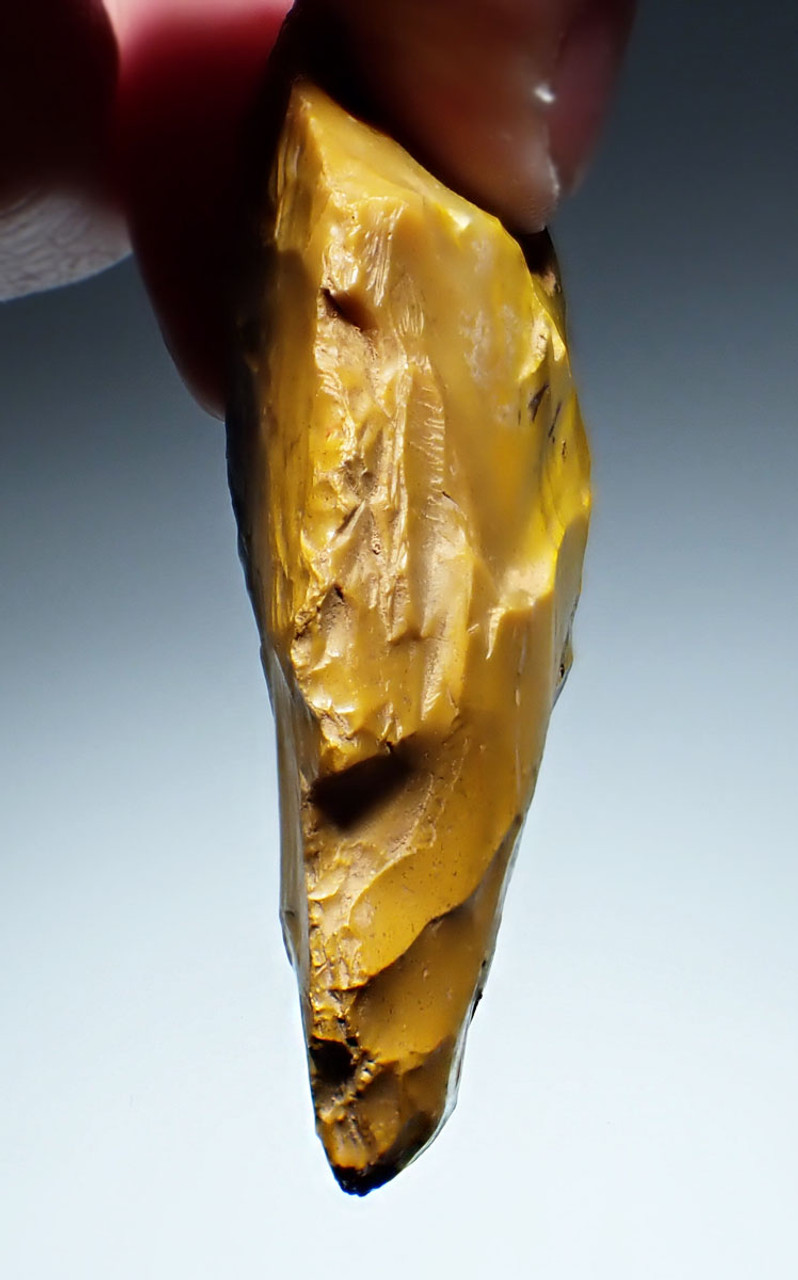Product Description
SEE MORE MOUSTERIAN NEANDERTHAL TOOLS
For comparison prices, please see the "Old World Typology and Price Guide" section of the "OVERSTREET IDENTIFICATION AND PRICE GUIDE TO INDIAN ARROWHEADS" editions 7th, 8th and 9th.
Fashioned out of rich, golden jasper that the famous Neanderthal Fontmaure site is known for, this superb BIFACE hand axe was fashioned by a Neanderthal over 40,000 year ago. Unlike their much larger predecessors of the Acheulien, Mousterian hand axes are much smaller in comparison. An ingenious finger grip design was flaked by its original Neanderthal maker as seem in the photos. The overall triangular design is well-executed, and the entire surface shows excellent flaking and shaping.
Unlike inferior surface-collected specimens that occasionally are offered on the market, this artifact was dug from the actual subterranean level that was once a Neanderthal occupation layer. What this means is that it was not weathered and damaged by exposure to the elements or plow. It features a rich natural soil sheen from long-term sediment burial and mineralization. Original minerals and patina deep in microscopic crevices and hinge fractures provide evidence of its prehistoric authenticity - traits not found in modern or altered copies. Our fortunate purchase of a private Belgian collection allows us to offer this SCARCE Neanderthal artifact.
Mousterian hand axes considered some of the rarest and most prized tools of the Neanderthals, more so when they are objects of unusual color or from a rare lithic as this is. Being fashioned out of bright golden jasper, this stone tool was surely prized by its Neanderthal artisan as much as any collector would admire it today!
Fine quality Mousterian Neanderthal artifacts with European provenance are RARE and often move from one private collection to the next. Most sites are now depleted, destroyed, or built over, and all are protected by law forbidding modern day digging. The market continues to demonstrate these top grade Paleolithic Early Man artifacts will continue to appreciate in price as collector demand outpaces the limited supply. Most collectors often buy pieces and never resell, adding to the scarcity of the supply. Investment aside, no Paleolithic collection should be without representative tools of one of the most famous primitive humans in history!
HISTORY
Out of the many archaeological sites in France containing Paleolithic objects, Fontmaure is one of the "Crown Jewels" of the period of the Neanderthals. This site is very small, spanning only approximately one acre. It gets its name from the neighboring farm where it is located. Artifacts from Fontmaure have been dated to at least 40,000 years old and are classified as from the Chatelperronian and Mousterian era, having been fashioned by the Neanderthal people. One of the unique published finds of Fontmaure is the very beautiful and unique jasper which is only found here and is primarily red and yellow. Many of the objects found in Fontmaure are made of this stone with other objects made of sandstone, flint and light gray quartz. This light gray quartz originates from a place that is situated about hundred kilometers from Fontmaure. Another unusual feature is that, to date, it is one of a few known open-air settlements. Even more interesting is the fact that along with the stone tools found, human and animal figures have also been excavated. There are also stones used in some type of ritual, such as triangular stones, round discs and stone balls (bolas) that have been discovered in Fontmaure. These art objects of the Neanderthals make up some of the oldest art known from Europe! Today, we find the unusual, bright colors of the Fontmaure Neanderthal tools to be intriguingly beautiful and no doubt, the Neanderthals of prehistory coveted and prized these pieces, as well!
 US DOLLAR
US DOLLAR
 EURO
EURO
 AUSTRALIAN DOLLAR
AUSTRALIAN DOLLAR
 CANADIAN DOLLAR
CANADIAN DOLLAR
 POUND STERLING
POUND STERLING






























